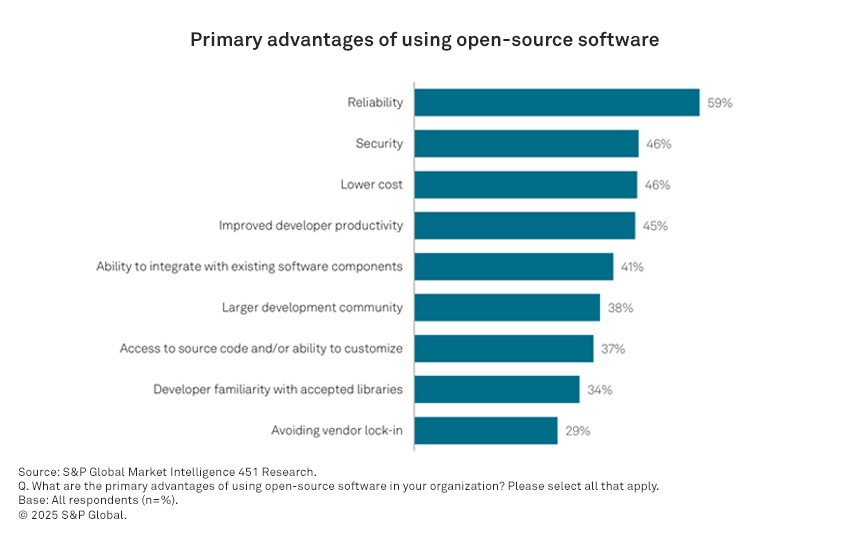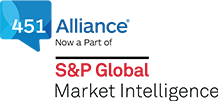
Source: DragonImages/Stock Photos | Technology/Getty Images.
According to a recently conducted study by S&P Global Market Intelligence 451 Research, open source remains a critical part of enterprise software development and deployment, driven by key advantages including reliability, security and lower cost. Nevertheless, open source comes with its own challenges including version consistency, complexity and support.
Open-source software remains a nearly ubiquitous and prominent part of the organization. Its staying power is in part because open source is critical to achieving higher-reliability and more secure software, while also saving money and driving developer productivity. These benefits are not achieved by simply using open-source software, with significant challenges in version consistency, security, complexity and the cost of support. The fact that security and cost are both advantages and challenges of open-source software highlights how its use must be carefully managed to be effective, reinforcing the value of consistent and standardized policies and guidelines for enterprise use of open source. Open-source software is also playing a key role in the use of generative AI in software development, helping define “open AI” and manifesting in the adoption of open-source models, which is not far behind the uptake of proprietary ones. Survey respondents overwhelmingly agree that open-source generative AI tools are advantageous to their software development.
Summary of findings
Open-source adoption is driven by key advantages including reliability (58% of survey respondents), security (46%), lower cost (46%) and improved developer productivity (45%), all of which are priorities for enterprise organizations (see Figure 1). By its nature, open-source software is developed by larger communities of developers that prioritize the quality and reliability of their code, which is further refined and improved with broader use. In terms of security, while open source can still be vulnerable, it tends to have more developers and more eyes on the code, which helps to bolster its security. Lower cost, which was ranked as the top advantage of open source in our 2024 survey, is associated with its free availability, though support typically entails some costs and many enterprises opt for paid versions for extensions, integrations and support. As for developer productivity, open source is inherently modular and made to integrate with other software components — both open source and proprietary — thus it tends to help developers work faster and more efficiently.

The biggest challenges of using open-source software are version consistency (35% of respondents), lack of security (34%), complexity (29%) and cost to support (29%); overcoming these hurdles is critical to achieving open-source advantages. Version consistency has always been a challenge with the many open-source projects, components and platforms in use at most enterprise organizations, particularly with the rapid cadence at which open-source software is updated. Open source can also introduce security risks, which is why most enterprises prioritize scanning and governance for internal use. In terms of complexity, software such as Kubernetes still represents a new paradigm for many organizations and its deployment typically means additional open-source components for scheduling, monitoring and observability, security, and other functionality. While open-source software may be free of royalty fees, it still requires skilled and experienced developers and IT operations teams to implement it effectively and efficiently, which requires investment and resources.
Open source is also playing a critical role in the use of generative AI in software development and deployment, helping to define “open AI“ and manifesting in the open-source models, tools and platforms that represent a significant portion of generative AI deployments and applications. Our survey indicates use of open-source pretrained models for generative AI (43% of respondents) is not far behind use of commercially licensed pretrained models (54%). In addition, we suspect open-source software is frequently a part of custom models built in-house (46%), as a growing number of organizations mix different models and tools and customize for their own, internal use. Survey respondents overwhelmingly agree (53% strongly, 42% somewhat) that open-source generative AI tools are advantageous to their software development, indicating it will likely remain a key part of generative AI adoption.
Compared with other types of software components used by organizations, open source (44% of respondents) trails internally developed custom software (55%) and third-party custom software (53%) but is ahead of commercial off-the-shelf software (37%). Again, we suspect open source is incorporated into both internally developed and third-party custom software components as well. This mixed use is reflective of an enterprise IT market that demands use of both open-source components — which are modular and can integrate with other open-source and proprietary components and platforms — and non-open-source components. Because effective use of open-source software is critical to realizing advantages, enterprise organizations must ensure they are adequately managing, monitoring and measuring their teams’ use of open source through clear and consistent policy and governance.
Want insights on DevOps trends delivered to your inbox? Join the 451 Alliance.

